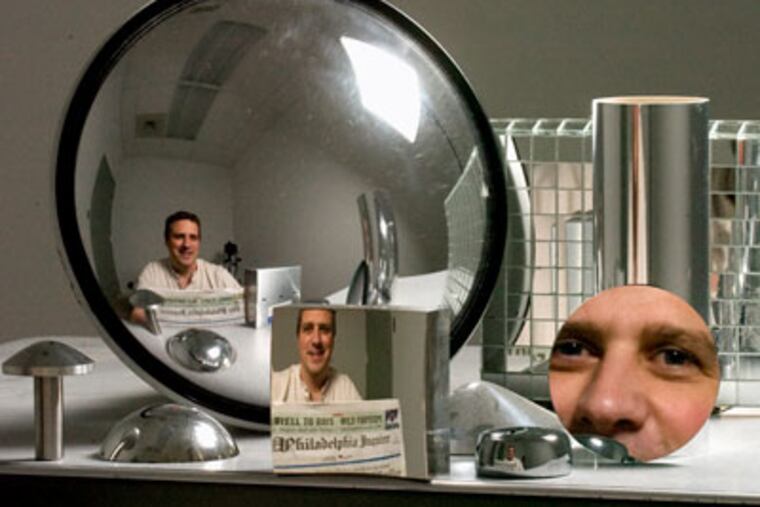At Drexel, he designs amazing mirrors
Mathematician Andrew Hicks was in his Drexel University office, puzzling over some problem he can no longer recall, when colleague Ron Perline walked in with a challenge.

Mathematician Andrew Hicks was in his Drexel University office, puzzling over some problem he can no longer recall, when colleague Ron Perline walked in with a challenge.
Fresh from his morning bicycle ride from Germantown, Perline was unhappy with the rearview mirror mounted on his handlebars. Its tiny surface was curved, reflecting a wide-angle view of the road behind him, but the image was badly distorted.
Could math provide the path to better reflection? Perline asked.
Indeed it could. Eight years and numerous calculations later, Hicks is now testing a prototype mirror - for a car, not a bike - and he is in talks with a foreign manufacturer. As with the bike mirror, the rounded surface provides a wide field of view - so wide that it eliminates the dreaded, driver-side "blind spot" - yet the subtle mathematics of his design result in little or no distortion.
He didn't stop there. The 42-year-old mathematician went on to design half a dozen other reflective surfaces for various applications - a few of them in collaboration with Perline - and they are like nothing you'd ever see on the bathroom wall.
Panoramic mirrors. Mirrors for use with high-tech surveillance cameras. Mirrors with odd, undulating surfaces that are fashioned with a computer-guided milling machine. And one wacky mirror that doesn't yield a mirror image at all. If you raise one hand while looking into the curved surface, your reflection appears to be raising the opposite hand.
It's not clear what use that one will have, beyond entertainment - Perline calls it "the vampire mirror" - but with his driver-side prototype, Hicks may be onto something.
Drexel has a patent pending on the technology, and a recent test showed promise. Working with representatives from the company, which he declined to identify for now, Hicks took the mirror out for a spin on the Schuylkill Expressway.
Whenever another car came up behind him on his left, he never lost sight of it, Hicks says. No blind spot.
"When it disappears in your mirror, it reappears in your sight," Hicks says. "It's complete continuity."
And unlike with Perline's bike-mounted device, the reflection is not skewed. A straight line in real life appears as a straight line in the Hicks mirror.
People have been manipulating light with mirrors for at least 8,000 years. That's when the earliest known reflective surfaces were manufactured - carved from volcanic glass in what is today south-central Turkey, according to Jay M. Enoch, a professor of optometry at the University of California, Berkeley.
Like Hicks, the ancients knew that a convex surface - one bulging outward toward the beholder - reflects a wider view of the world.
But armed with a computer, Hicks can customize his creations with exquisite precision. He achieves the desired effect first by characterizing the problem with sophisticated equations. He then programs a computer to spit out the coordinates for tens of thousands of points on the mirror's surface - each one tilted differently to reflect light in just the right way.
The data are then sent to B-Con Engineering, a Canadian firm that uses a milling machine to make the mirrors out of aluminum. The metal is ground and polished with a diamond bit until the smooth, curvy surfaces emerge - a process that takes up to a day for Hicks' unusual free-form designs, says company president Brian Creber.
Like Perline's bike mirror and the mirrors of ancient Turkey, Hicks' new automotive mirror is convex. This provides a wide, 45-degree field of view, instead of the narrow 15 or 20 degrees afforded by a typical flat driver-side mirror.
Objects in the prototype mirror also appear to be farther away; if more things are crammed into the picture, obviously, they have to appear smaller.
For that reason, United States regulations do not allow curved driver-side mirrors, on the theory that drivers are better served by seeing how far away things are - even if they can't see as much.
Hicks hopes to sell his design overseas, where it would be allowed - reasoning that a motorist might prefer to see more things, even if they are smaller. (U.S. rules do allow curved mirrors on the passenger side, but they must include the warning "Objects in Mirror Are Closer Than They Appear.")
While there are no specific data on how many accidents are related to poor rearview vision, statistics suggest there is room for improvement.
In 2007, 353,000 vehicles were involved in crashes in which one of the cars was merging or changing lanes, according to the National Highway Traffic Safety Administration. That figure represents nearly 4 percent of all vehicles that crashed.
The exposure to real-world regulations and patents is a little new for Hicks, whose Ph.D., from the University of Pennsylvania, was in a more abstract field of math.
"I'm not naturally an entrepreneur," he says.
But he has embraced the applications of his craft with gusto. Even before tackling the rear-view automotive challenge, he had designed panoramic mirrors to help robots "see."
Among Hicks' other projects is using arrays of tiny micro-mirrors that could be programmed to capture hundreds of overlapping images on video. When these images were "stitched together" with software, the result would have an extremely high resolution - potentially useful for surveillance.
The tilt of each mirror is programmable, so the user could selectively zoom in on various objects or people, Hicks says.
As for the original bike-mirror project, he never got around to it.
"I wish I had 48 hours in a day," he laments.
Apparently, mirrors can't expand time. Yet.